COLORED CACTI
"CACTI AND OTHER XEROPHYLOUS PLANTS", 2000, #3
Innokentiy E. Sinev, Moscow
(Brief version)
The editor's desk. This year we decided to show our readers, especially beginner cactophyles that many hundreds of beautiful plants can be found among common natural forms of cacti and succulents and they are not inferior to cultivars in beauty. The summary article is presented below. Others are: "Color of spines", "Color of tomentum", "Color of epidermis", "Coloration of flowers". The subject is description of cacti and other succulents. We are inviting all interested people to help to collect information on these topics. Please write us or send articles from other journals on the subject. We are also asking you to share with us the photos on the subject or send Internet links to the photos.
The photographs were taken by Alexander Usikov, www.cactusomania.ru (Togliatti, Russia), Sergey Kalmykov (Krasnodar, Russia), Oleg Pikalev (Moscow, Russia), Keith and Lorraine Thomas http://home.inreach.com/klcactus (USA), Giovanni Quarella http://www.cactofilia.com (Italy), The photographs of red cacti are from the book of Dmitry Semenov "Cacti and other succulents at home and outside".
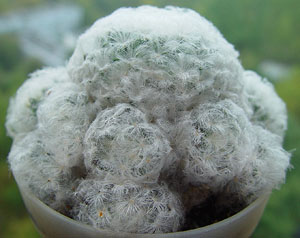 |
| Photo 1. |
The coloration of cactus is determined by 3 factors such as color of spination, color of tomentum and color of epidermis. The most of cacti has green epidermis and greyish spination. The dominating color is green. This is very natural for a plant but "colored" cacti are not green. As you would expect the number of them is much smaller than common green ones.
White (photo 1-2) cacti are the most numerous. Firstly, one might name white columnar cacti such as Cephalocereus senilis from Mexico, numerous genera of peruvian and bolivian mountain columnar cacti Оrеосеrеus, Espostoa, Pseudoespostoa etc.
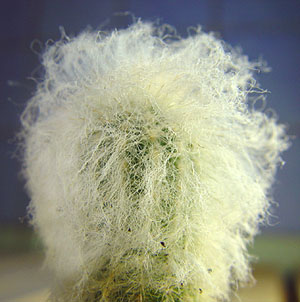 |
| Photo 2. |
Lofty beauty of these plants is determined by dense white woolly hairs that allow plants not only successfully withstand sizzling rays of equatorial mountain sun but also resist to quick cooling of stem in rarefied air at nighttime. Furthemore the tomentum helps effectively intercept and condense moisture of mountain mists which is partially absorbed by hair-like spines and transported inside of stem but mostly flows down to root space in the soil.
Beautiful tomentum also distinguishes species of Pilosocereus and Austrocephalocereus. Austrocephalocereus dybowskii from equatorial regions of Brazil is the most often found in our collections among other species of Austrocephalocereus.
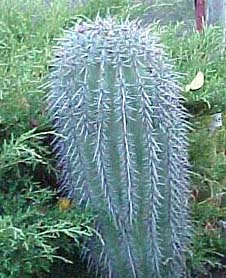 |
| Photo 3. |
In opinion of the foreign cactologists the most popular cactus in all collections in the world is Astrophytum myriostigma, the white cactus from Central and Northern Mexico. All species of Epithelanta are white. Echinomastus macdowellii also has very beautiful white long spines. The spines serves as a good background to striking bright purple-red flowers amazingly breaking out through dense and very long spines.
Apparently genus Mammillaria has the greatest amount of white cacti. М. albicoma, M. bella, M. bocasana. M. candida, M. chinocephala, M. geregia, M. geminispina, M. geminispina v. nobile, M. hahniana, M. herrerae, M. humboldtii, M. lanata, M. lasiacantha, M. lenta, M. parkinsonii, М. рlumosa, M. pseudoperbella are the best known. These species have either very dense white spines or dense white pubescence in axils or both.
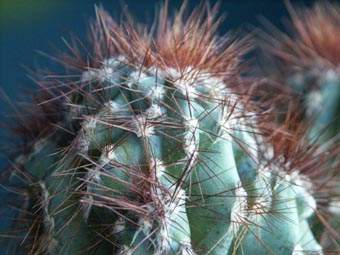 |
| Photo 4. |
Many species of Parodia also have dense white tomentum but the spines have other color. Pure white species are quite rare. One of them is a popular Р. nivosa forming bright red flowers all summer. Brasilicactus haselbergii produce very beautiful white stem but flowering is more difficult. White species of Rebutia and Aylostera are very popular among beginners, for example, Rebutia senilis and Aylostera muscula.
The color of blue (photo 3-4) cacti is determined by coloration of epidermis which is determined by light conditions no less than the white coloration is.
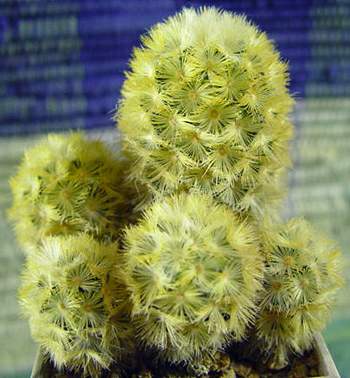 |
| Photo 5. |
One of the most widespread blue cacti is columnar Myrtillocactus geometrizans. It forms thick triquetrous black spines in good conditions. Neochilenia paucicostata has a beautiful light blue stem. Lobivia glauca и Acanthocalycium griseum have darker color of epidermis. Melocacti with blue epidermis are very spectacular. For example, М. orcuttii, M. pachyacanthus, M. ferreophilus, M. douradensis and especially M. azureus. Blue epidermis with purple spots characterize bigger species of mexican Echinocactus. Ferocactus emoryi forms a beautiful blue stem. The new growth of this cactus has different hues of red and purple. The blue cacti with bright yellow spines, for example, Ferocactus glaucescens, Eriocactus magnificus have very striking appearance.
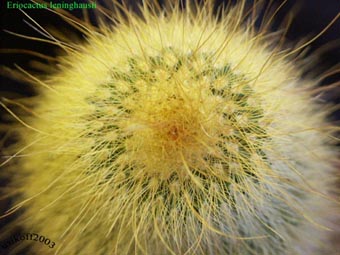 |
| Photo 6. |
Yellow (golden) cacti also very beautiful (photos 5-6). The big specimens of Echinocactus grusonii always are the clou of botanical gardens. The nice regular stems of this species are covered by dense golden spines. The Americans call this species "golden barrel". In spite of exactingness grafting is not recommended. The other popular golden cactus is brazilian Eriocactus leninghausii. The golden candles of these cacti profusively cluster from the base and produce yellow flowers in maturity.
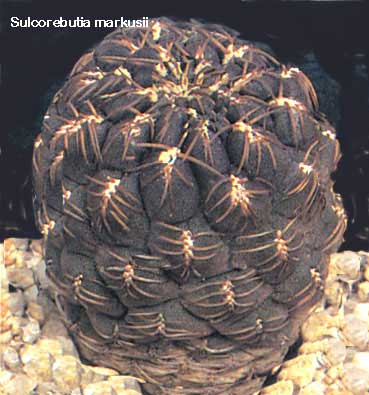 |
| Photo 7. |
The other golden cactus from Southern Brazil, also related to Notocactus, miniature Brasilicactus graessneri flowers more readily. Winterocereus (Hildewintera) aureispinus from Bolivia have even brighter golden spines and easier in culture. Their stems have tendency to trail so they are very often grown as pendant plant. We know only one golden species of Opuntia which is O.scheeri. One of varieties of O. microdaisis has paler yellow color. This variety doesn't have spines and the pads are densely covered by areoles with colored glochids. We have to say that other varieties of this species also has bright coloration – from white and yellow through different tints of brown to almost red. The most known golden Mammillaria is M. carmenae.
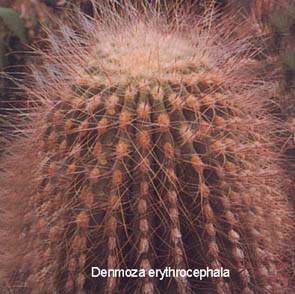 |
| Photo 8. |
Echinocereus fitchii, Е. pectinatus, E. castaneus have nice brown (photo 7-8) color. Very beautiful Echinocereus pectinatus var. rigidissimus has different color of growyh in different years: from light pink to dark brown. You can find different shadows of brown in genus Haageocereus.
Brown color of epidermis is typical for "chileans", among them you can find all tints of brown. Coloration of epidermis of "chileans" is phenomenal. Normal green plants can be found rarely among colored ones. Other genera also have brown plants. Chocolate-brown F. castanea and red-brown F. cataphracta from genus Frailea are always popular. Gymnocalycium gibbosum var. nobile has nice purplish brown color.
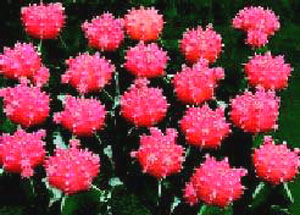 |
| Photo 9. |
There are very few red (photo 9)cacti. That explains huge popularity of bright red japanese "Hibotan"-like cultivars without chlorophyll.
In bright light you can see brownish red (photo 10-11) epidermis color of G. mihanovichii v. friedrichii from genus Gymnocalycium. Neochilenia odieri has very similar coloration. Red spines determine color of both species of Denmosa, short columnar cacti from Argentina. Ferocactus acanthodes F. coloratus, F. graclis, F. stainesii. have even brighter red spines.
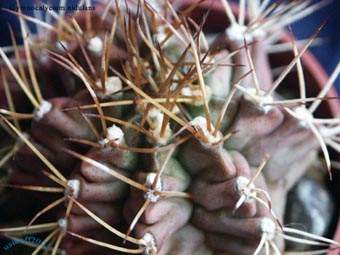 |
| Photo 10. |
Cacti with black, purple and purplish black (photo 12-13) epidermis are typical mainly for South America. For example, Neochilenia atra, Horridocactus geisseyi, H.crispus, Gymnocalycium gibbosum var. nigrum etc.
Finally we have to notice that colored cacti become more bright ant colorful only in good light conditions. So sometimes it'd be better to sacrifice quick growth and move cacti from hot but shaded greenhouse outside. Growth of the cacti will sharply slow down but color will be ideal. It will also work for other succulents.
Literature:
1. Backeberg С. - Das Kakteenlexicon. Jena, 1976.
2. Backeberg С. - Wunderwelt Kakteen. Jena, 1966.
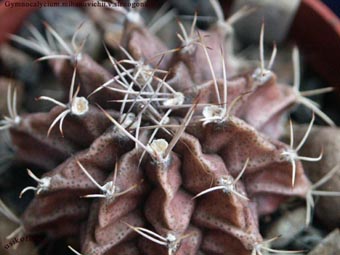 |
| Photo 11. |
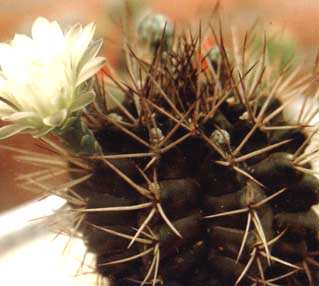 |
| Photo 12. |
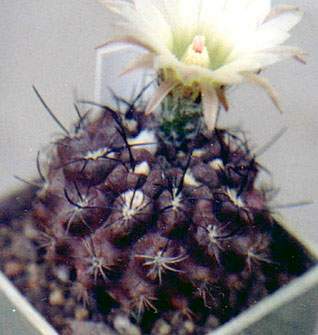 |
| Photo 13. |





